Charles E W Bean, Diaries, AWM38 3DRL 606/275/1 - 1918 - 1938 - Part 13
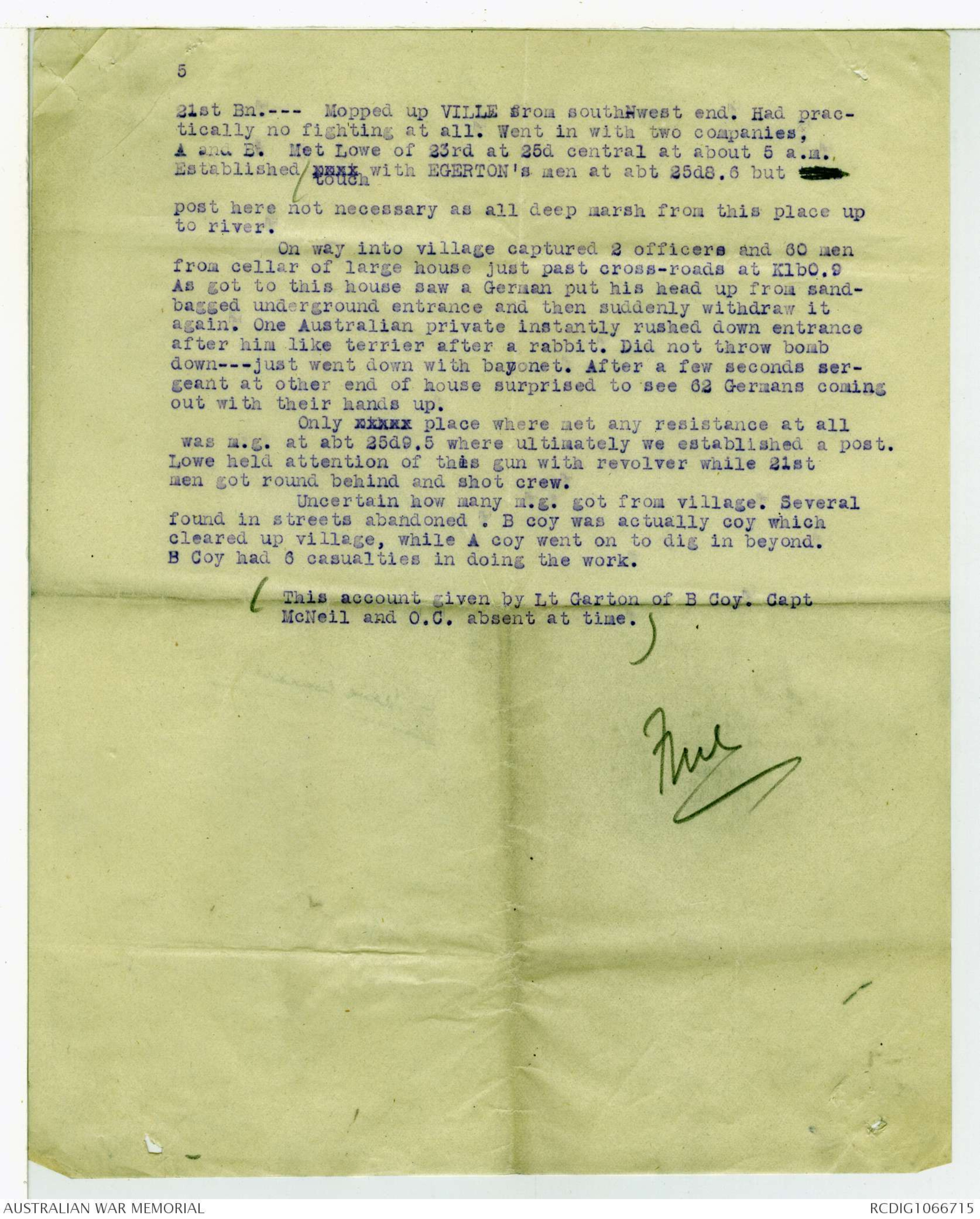


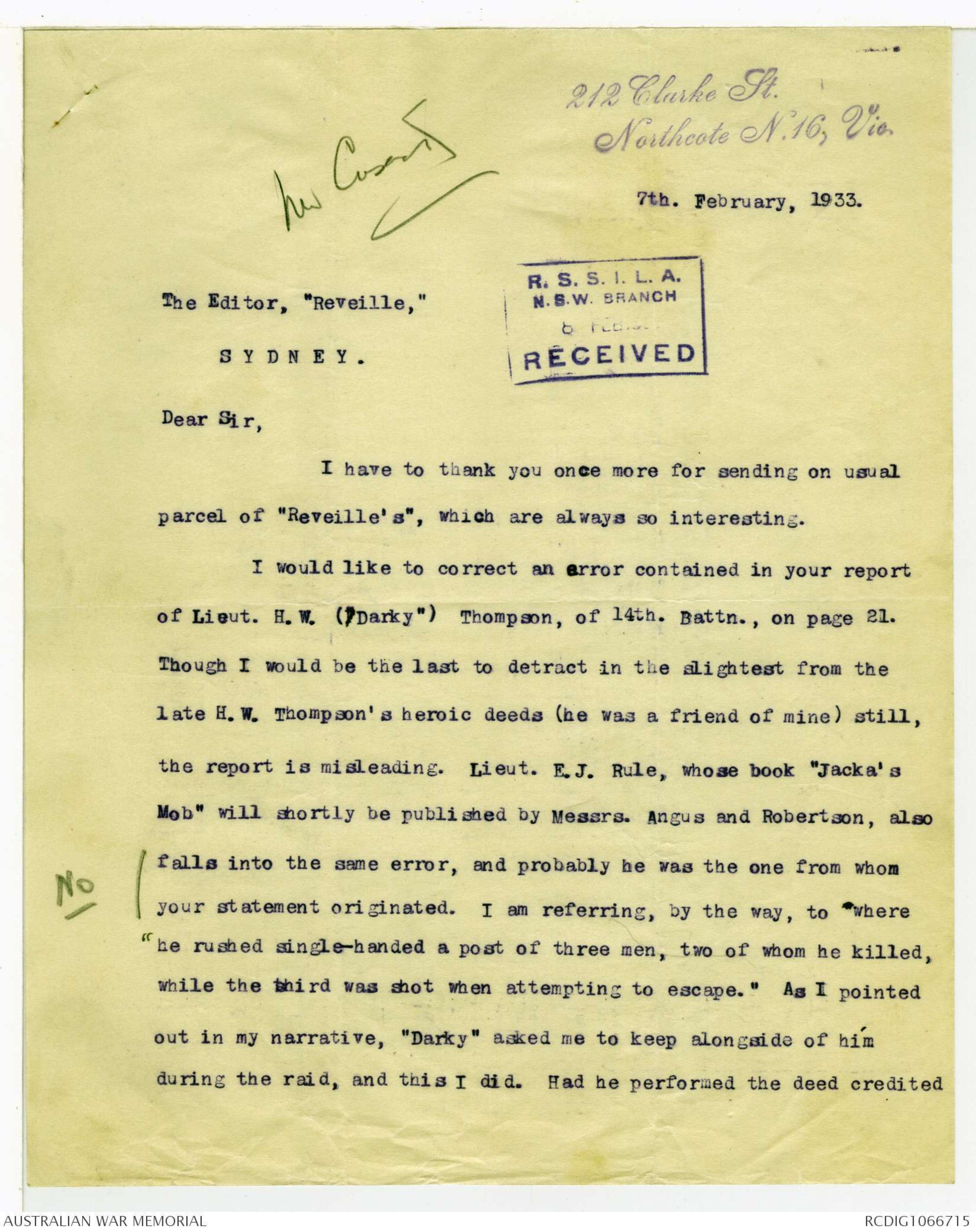
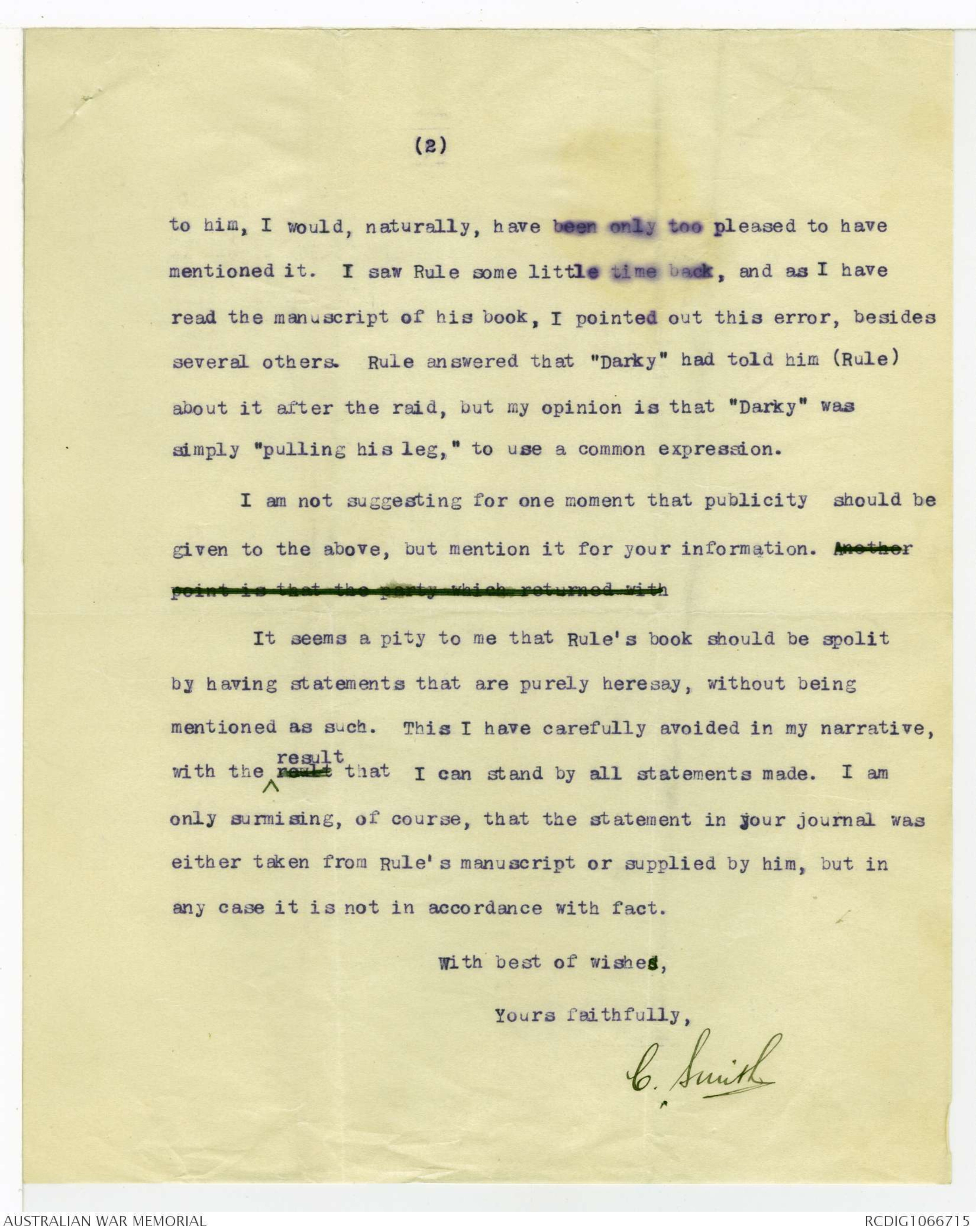
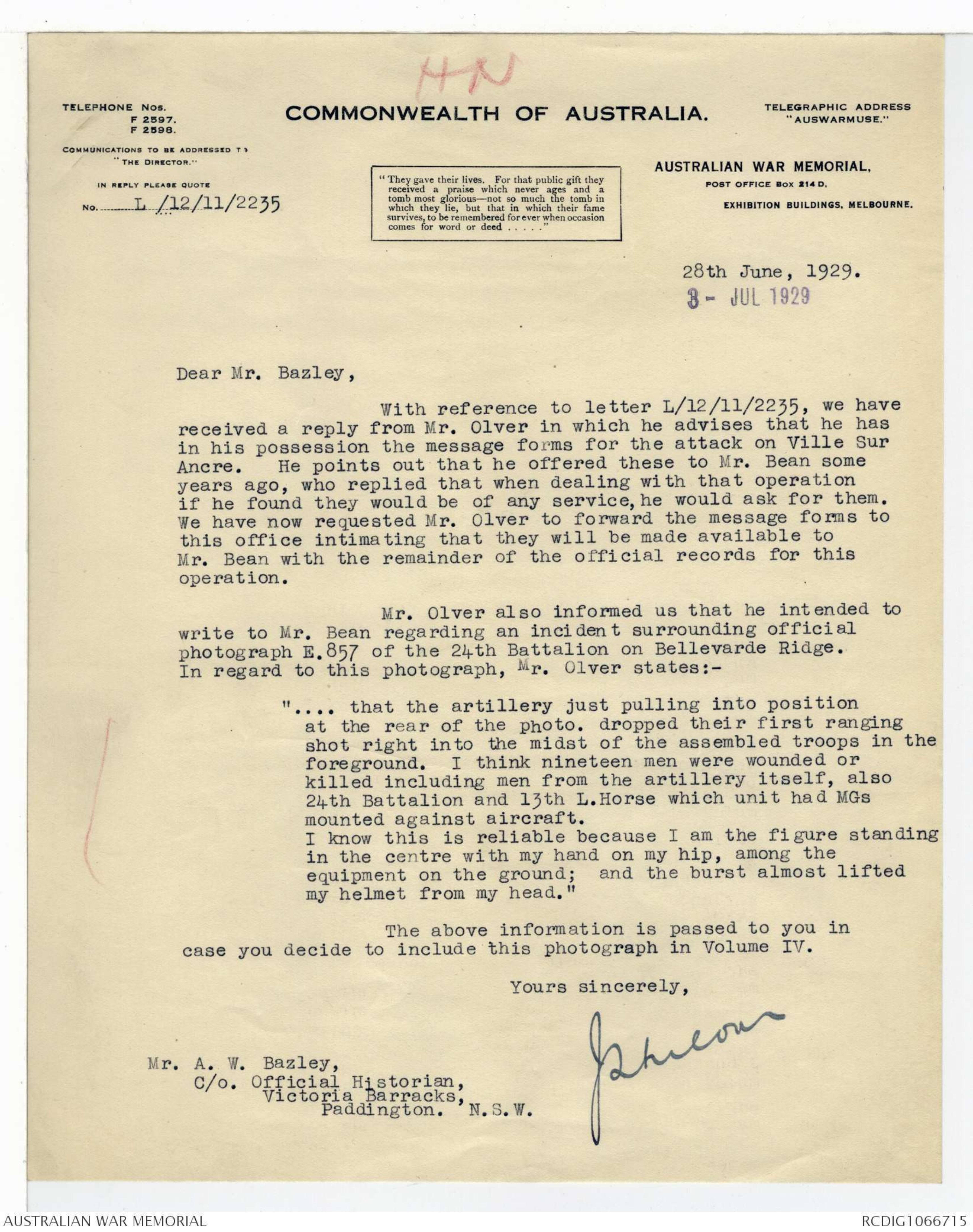
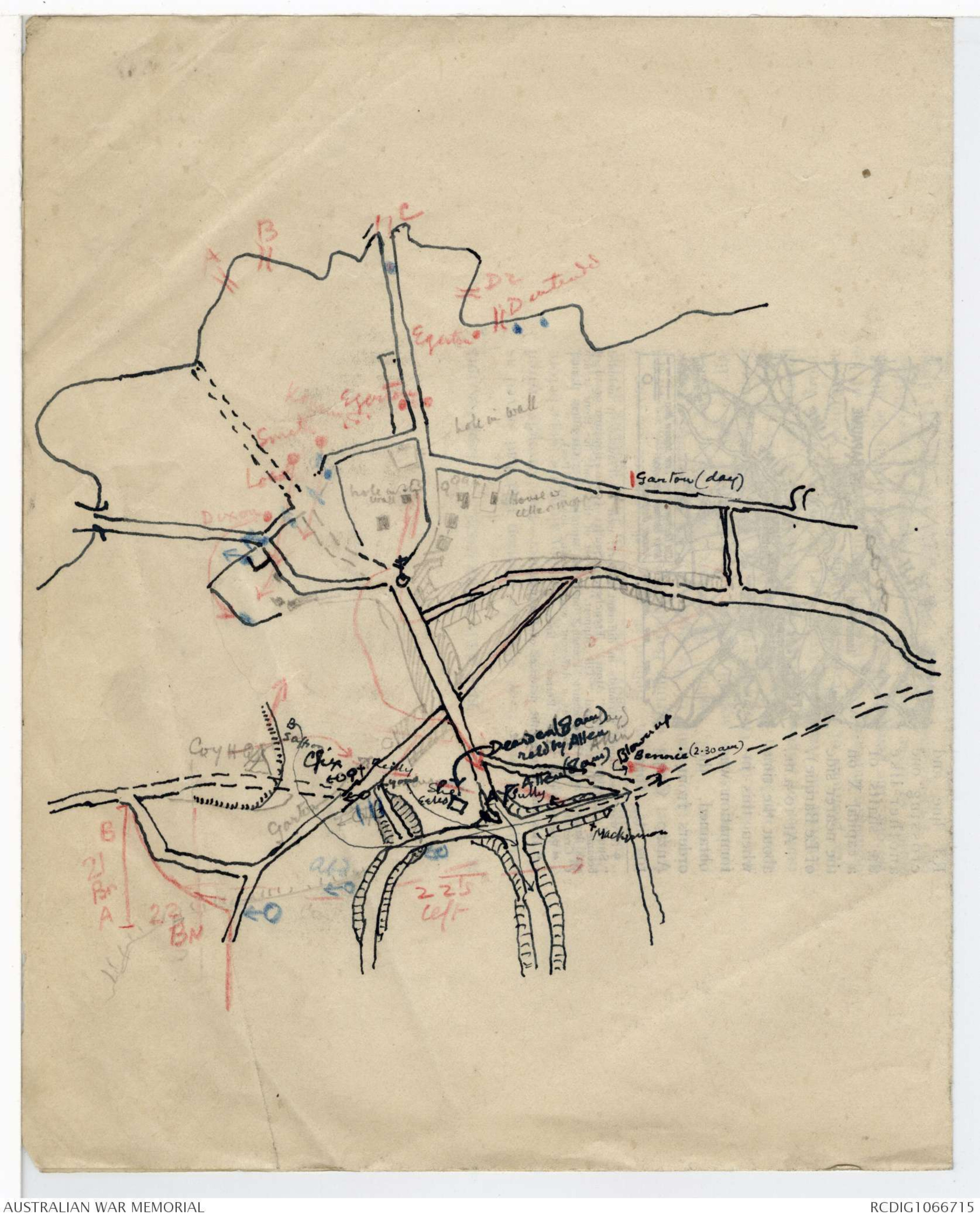
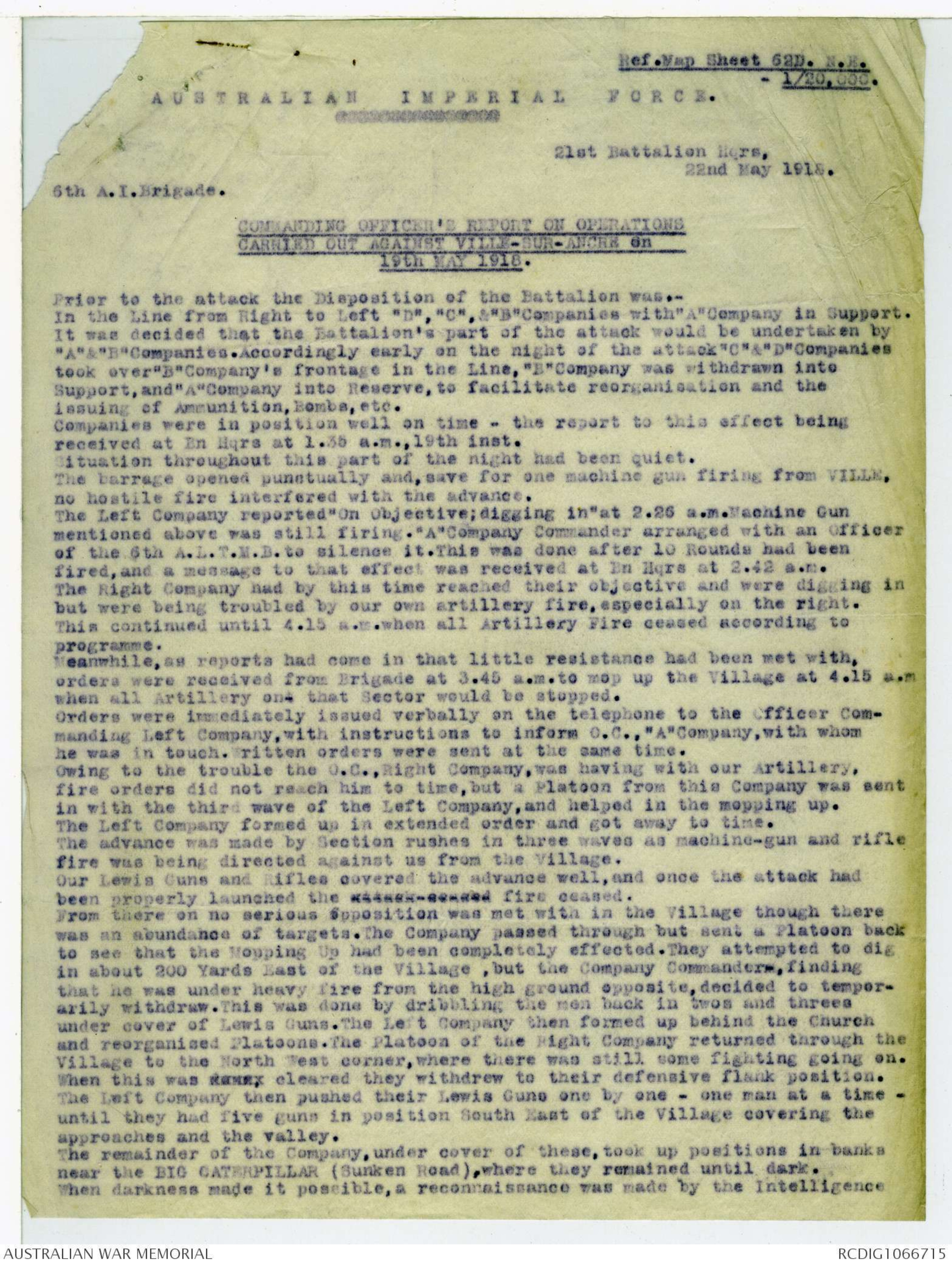
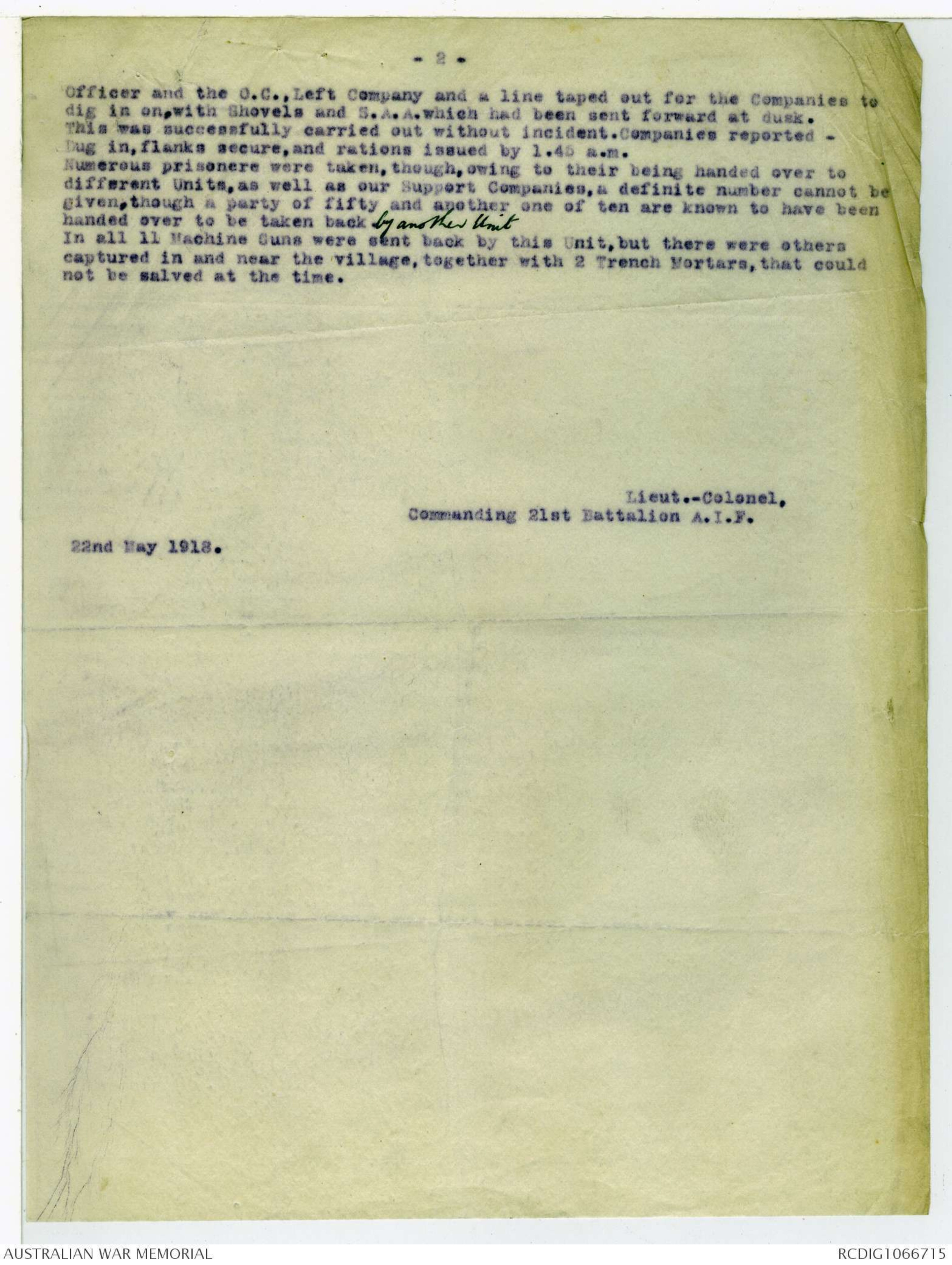
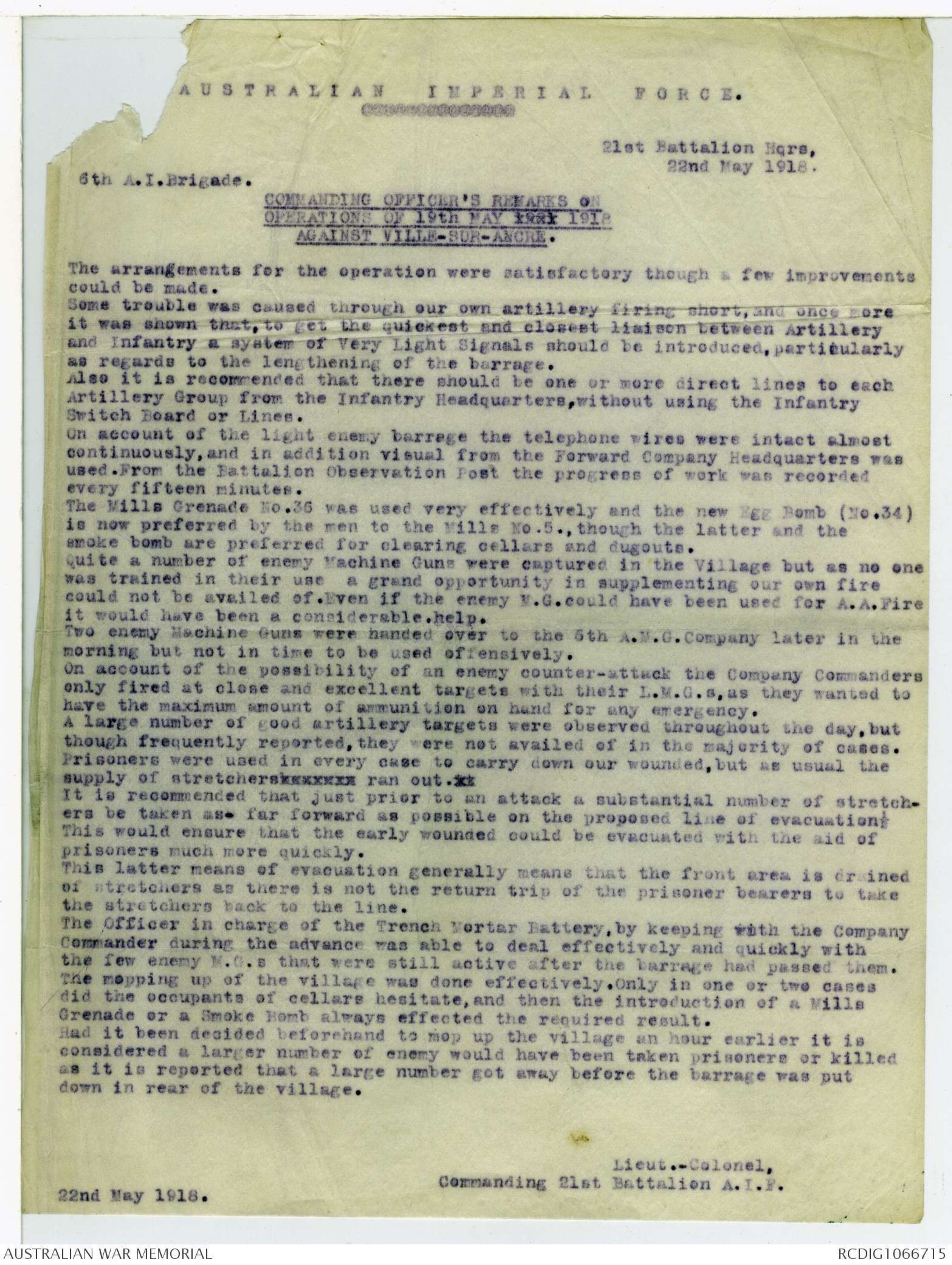
5
21st Bn.--- Mopped up VILLE from south-west end. Had practically
no fighting at all. Went in with two companies,
A and B. Met Lowe of 23rd at 25d central at about 5 a.m.
Established xxx touch with EGERTON's men at abt 25d8.6 but xxx
post here not necessary as all deep marsh from this place up
to river.
On way into village captured 2 officers and 60 men
from cellar of large house just past cross-roads at K1b0.9
As got to this house saw a German put his head up from
sandbagged underground entrance and then suddenly withdraw it
again. One Australian private instantly rushed down entrance
after him like terrier after a rabbit. Did not throw bomb
down---just went down with bayonet. After a few seconds sergeant
at other end of house surprised to see 62 Germans coming
out with their hands up.
Only xxxx place where met any resistance at all
was m.g. at abt 25d9.5 where ultimately we established a post.
Lowe held attention of this gun with revolver while 21st
men got round behind and shot crew.
Uncertain how many m.g. got from village. Several
found in streets abandoned . B coy was actually coy which
cleared up village, while A coy went on to dig in beyond.
B Coy had 6 casualties in doing the work.
(This account given by Lt Garton of B Coy. Capt
McNeil and O.C. absent at time.)
[[FM?]]
[*To go in folder 275
H.N.*]
Caldermeade
Sth Gippsland.
Victoria
6th June 1944
Capture of
Ville sur Ancre,
19 May 1918.
Dr. C. E. W. Bean.
Lindfield.
N.S.W.
Dear Sir.
May I express my sincere appreciation of your reply
to my letter and narrative which you acknowledge in your letter of
May 31st. That you will see that justice is done to my men and will,
if at all possible, amend the main history. does indeed set my
mind at rest. I trust that the information I have given you will
be of assistance to you in your inquiries.
My reference to "a panic". I should not have used that expression
"Commotion". should have been the word. May I here explain:-
A few days after the Capture of Ville-Sur-Ancre the Battalions were
'relieved' from the Line & were resting in rear. I noticed quite
some activity, commotion, at 21st Battalion H.Qrs. Anticipating
a move to some other sector, I made inquiries from one of
our own staff and was told that as Capt. Cutlack had been
very outspoken in expressing his contempt for the lack of dash,
by such fine troops as the 21st Battalion, and thier failure to hold
Ville, to some of the staff at Division or it may have been Corps HQ.
Warning had been received by 21st Battalion of Cutlacks statements,
and the suggestion made that 21stBn & 23 Bn reports of attack on Ville
should harmonize in the event of Cutlacks remarks reaching
the Generals ears. The sequel to the 'commotion' which I
had noticed was the 'Inquiry' held the next morning.
The Capt Cutlack to whom I have referred was the 'War Correspondent'
Yours sincerely
J.A. Wiltshire
212 Clarke St.
Northcote N.16, Vic.
[*[NW Cusons?*]
7th. February, 1933.
[*R.S.S.I.L.A.
N.S.W. BRANCH
8 FEB [?]
RECEIVED*]
The Editor, "Reveille,"
SYDNEY.
Dear Sir,
I have to thank you once more for sending on usual
parcel of "Reveille's", which are always so interesting.
I would like to correct an error contained in your report
of Lieut. H.W. ("Darky") Thompson, of 14th. Battn., on page 21.
Though I would be the last to detract in the slightest from the
late H.W. Thompson's heroic deeds (he was a friend of mine) still,
the report is misleading. Lieut. E.J. Rule, whose book "Jacka's
Mob" will shortly be published by Messrs. Angus and Robertson, also
[*No*]
falls into the same error, and probably he was the one from whom
your statement originated. I am referring, by the way, to where
"he rushed single-handed a post of three men, two of whom he killed,
while the third was shot when attempting to escape." As I pointed
out in my narrative, "Darky" asked me to keep alongside of him
during the raid, and this I did. Had he performed the deed credited
2
to him, I would naturally, have been only too pleased to have
mentioned it. I saw Rule some little time back, and as I have
read the manuscript of his book, I pointed out this error, besides
several others. Rule answered that "Darky" had told him (Rule)
about it after the raid, but my opinion is that "Darky" was
simply "pulling his leg," to use a common expression.
I am not suggesting for one moment that publicity should be
given to the above, but mention it for your information. Anotherpoint is that the party which returned with
It seems a pity to me that Rule's book should be spolit
by having statements that are purely heresay, without being
mentioned as such. This I have carefully avoided in my narrative,
with the reult ^result that I can stand by all statements made. I am
only surmising, of course, that the statement in your journal was
either taken from Rule's manuscript or supplied by him, but in
any case it is not in accordance with fact.
With best of wishes,
Yours faithfully,
C. Smith
[*HN*]
TELEPHONE NOS.
F 2597.
F 2598.
COMMUNICATIONS TO BE ADDRESSED TO
"THE DIRECTOR."
IN REPLY PLEASE QUOTE
NO. L /12/11/2235
TELEGRAPHIC ADDRESS
"AUSWARMUSE."
COMMONWEALTH OF AUSTRALIA.
AUSTRALIAN WAR MEMORIAL,
POST OFFICE BOX 214 D.
EXHIBITION BUILDINGS, MELBOURNE.
"They gave their lives. For that public gift they
received a praise which never ages and a
tomb most glorious—not so much the tomb in
which they lie, but that in which their fame
survives, to be remembered forever when occasion
comes for word or deed . . . . ."
28th June, 1929.
[*3 - JUL 1929*]
Dear Mr. Bazley,
With reference to letter L/12/11/2235, we have
received a reply from Mr. Olver in which he advises that he has
in his possession the message forms for the attack on Ville Sur
Ancre. He points out that he offered these to Mr. Bean some
years ago, who replied that when dealing with that operation
if he found they would be of any service,he would ask for them.
We have now requested Mr. Olver to forward the message forms to
this office intimating that they will be made available to
Mr. Bean with the remainder of the official records for this
operation.
Mr. Olver also informed us that he intended to
write to Mr. Bean regarding an incident surrounding official
photograph E.857 of the 24th Battalion on Bellevarde Ridge.
In regard to this photograph, Mr. Olver states:-
".... that the artillery just pulling into position
at the rear of the photo. dropped their first ranging
shot right into the midst of the assembled troops in the
foreground. I think nineteen men were wounded or
killed including men from the artillery itself, also
24th Battalion and 13th L.Horse which unit had MGs
mounted against aircraft.
I know this is reliable because I am the figure standing
in the centre with my hand on my hip, among the
equipment on the ground; and the burst almost lifted
my helmet from my head."
The above information is passed to you in
case you decide to include this photograph in Volume IV.
Yours sincerely,
J. L Treloar
Mr. A. W. Bazley,
C/o. Official Historian,
Victoria Barracks,
Paddington. N.S.W.
Diagram - see original document.
Ref.Map Sheet 62D. N.E.
- 1/20,000.
AUSTRALIAN IMPERIAL FORCE.
21st Battalion Hqrs,
22nd May 1918.
6th A.I.Brigade.
COMMANDING OFFICER'S REPORT ON OPERATIONS
CARRIED OUT AGAINST VILLE-SUR-ANCRE on
19th MAY 1918.
Prior to the attack the Disposition of the Battalion was.-
In the Line from Right to Left "D", "C", & "B"Companies with "A"Company in Support.
It was decided that the Battalion's part of the attack would be undertaken by
"A" & "B" Companies. Accordingly early on the night of the attack "C" & "D" Companies
took over "B" Company's frontage in the Line, "B" Company was withdrawn into
Support, and "A" Company into Reserve, to facilitate reorganisation and the
issuing of Ammunition, Bombs, etc.
Companies were in position well on time - the report to this effect being
received at Bn Hqrs at 1.35 a.m., 19th inst.
Situation throughout this part of the night had been quiet.
The barrage opened punctually and, save for one machine gun firing from VILLE,
no hostile fire interfered with the advance.
The Left Company reported "On Objective; digging in" at 2.25 a.m. Machine Gun
mentioned above was still firing. "A" Company Commander arranged with an Officer
of the 6th A.L.T.M.B. to silence it. This was done after 10 rounds had been
fired, and a message to that effect was received at Bn Hqrs at 2.42 a.m.
The Right Company had by this time reached their objective and were digging in
but were being troubled by our own artillery fire, especially on the right.
This continued until 4.15 a.m. when all Artillery Fire ceased according to
programme.
Meanwhile, as reports had come in that little resistance had been met with,
orders were received from Brigade at 3.45 a.m. to mop up the Village at 4.15 a.m
when all Artillery ond that Sector would be stopped.
Orders were immediately issued verbally on the telephone to the Officer Commanding
Left Company, with instructions to inform O.C., "A" Company, with whom
he was in touch. Written orders were sent at the same time.
Owing to the trouble the O.C., Right Company, was having with our Artillery,
fire orders did not reach him to time, but a Platoon from this Company was sent
in with the third wave of the Left Company, and helped in the mopping up.
The Left Company formed up in extended order and got away to time.
The advance was made by Section rushes in three waves as machine-gun and rifle
fire was being directed against us from the Village.
Our Lewis Guns and Rifles covered the advance well, and once the attack had
been properly launched the attack ceased fire ceased.
From there on no serious opposition was met with in the Village though there
was an abundance of targets. The Company passed through but sent a Platoon back
to see that the Mopping Up had been completely effected. They attempted to dig
in about 200 yards East of the Village, but the Company Commanders, finding
that he was under heavy fire from the high ground opposite, decided to temporarily
withdraw. This was done by dribbling the men back in twos and threes
under cover of Lewis Guns. The Left Company then formed up behind the Church
and reorganised Platoons. The Platoon of the Right Company returned through the
Village to the North West corner, where there was still some fighting going on.
When this was xxxxx cleared they withdrew to their defensive flank position.
The Left Company then pushed their Lewis Guns one by one - one man at a time -
until they had five guns in position South East of the Village covering the
approaches and the valley.
The remainder of the Company, under cover of these, took up positions in banks
near the BIG CATERPILLAR (Sunken Road), where they remained until dark.
When darkness made it possible, a reconnaissance was made by the Intelligence
2
Officer and the O.C., Left Company and a line taped out for the Companies to
dig in on, with Shovels and S.A.A. which had been sent forward at dusk.
This was successfully carried out without incident. Companies reported -
Dug in, flanks secure, and rations issued by 1.45 a.m.
Numerous prisoners were taken, though,owing to their being handed over to
different Units, as well as our Support companies, a definite number cannot be
given, though a party of fifty and another one of ten are known to have been
handed over to be taken back
[*by another Unit*]
In all 11 Machine Guns were sent back by this Unit, but there were others
captured in and near the village, together with 2 Trench Mortars, that could
not be salved at the time.
Lieut.-Colonel,
Commanding 21st Battalion A.I.F.
22nd May 1918.
AUSTRALIAN IMPERIAL FORCE.
xxxxxx
21st Battalion Hqrs,
22nd May 1918.
6th A.I.Brigade.
COMMANDING OFFICER'S REMARKS ON
OPERATIONS OF 19TH MAY 1981 1918
AGAINST VILLE-SUR-ANCRE.
The arrangements for the operation were satisfactory though a few improvements
could be made.
Some trouble was caused through our own artillery firing short,and once more
it was shown that, to get the quickest and closest liaison between Artillery
and Infantry a system of Very Light Signals should be introduced, particularly
as regards to the lengthening of the barrage.
Also it is recommended that there should be one or more direct lines to each
Artillery Group from the Infantry Headquarters, without using the Infantry
Switch Board or Lines.
On account of the light enemy barrage the telephone wires were intact almost
continuously, and in addition visual from the Forward Company Headquarters was
used. From the Battalion Observation Post the progress of work was recorded
every fifteen minutes.
The Mills Grenade No.36 was used very effectively and the new Egg Bomb (No.34)
is now preferred by the men to the Mills No.5, though the latter and the
smoke bomb are preferred for clearing cellars and dugouts.
Quite a number of enemy Machine Guns were captured in the Village but as no one
was trained in their use a grand opportunity in supplementing our own fire
could not be availed of. Even if the enemy M.G. could have been used for A.A.Fire
it would have been a considerable.help.
Two enemy Machine Guns were handed over to the 5th A.M.G. Company later in the
morning but not in time to be used offensively.
On account of the possibility of an enemy counter-attack the Company Commanders
only fired at close and excellent targets with their L.M.G.s, as they wanted to
have the maximum amount of ammunition on hand for any emergency.
A large number of good artillery targets were observed throughout the day, but
though frequently reported, they were not availed of in the majority of cases.
Prisoners were used in every case to carry down our wounded, but as usual the
supply of stretchersxxxxxxx ran out.xk
It is recommended that just prior to an attack a substantial number of stretchers
be taken as far forward as possible on the proposed line of evacuation½
This would ensure that the early wounded could be evacuated with the aid of
prisoners much more quickly.
This latter means of evacuation generally means that the front area is drained
of stretchers as there is not the return trip of the prisoner bearers to take
the stretchers back to the line.
The Officer in charge of the Trench Mortar Battery, by keeping with the Company
Commander during the advance was able to deal effectively and quickly with
the few enemy M.G.s that were still active after the barrage had passed them.
The mopping up of the village was done effectively. Only in one or two cases
did the occupants of cellars hesitate, and then the introduction of a Mills
Grenade or a Smoke Bomb always effected the required result.
Had it been decided beforehand to mop up the village an hour earlier it is
considered a larger number of enemy would have been taken prisoners or killed
as it is reported that a large number got away before the barrage was put
down in rear of the village.
Lieut-Colonel,
Commanding 21st Battalion A.I.F.
22nd May 1918.
 Sam scott
Sam scottThis transcription item is now locked to you for editing. To release the lock either Save your changes or Cancel.
This lock will be automatically released after 60 minutes of inactivity.